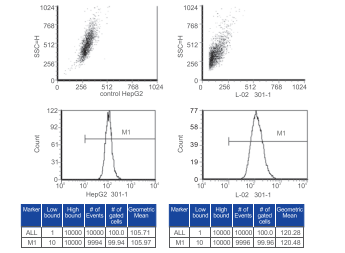Product Description
Mouse Anti S-AdenosylHomocysteine (SAH) Clone 301-1 | MA00301 | Arthus Biosystems
Product name
Mouse anti-SAH la/b
Catalog Number
MA00301-50/100
Description
Mouse monoclonal antibody against S-Adenosylhomocysteine [301-1]
Specificity
MA00301 shows the following reactivities with related compounds: S-Adenosylhomocysteine: 100%, S-Adenosylmethionine: -1.5%, Adenosine: <1 %, Homocysteine: < 1%, L-Cysteine: < 1%, Glutathione: < 1%, L-Cystathionine: < 1%, Methythioadenosine (MTA): < 5%, ADP (adenosine diphosphate): < 1%, ATP (adenosine triphosphate): < 1%.
Immunogen
S-Adenosylhomocysteine conjugated to BSA
Properties
Form
Liquid
Storage instructions
Store at 4°C, -20°C for long term storage
Storage buffer
PBS 10mM pH7.4 (NaCI 150mM), Sodium azide 0.02%, BSA 10mg/m1 or PBS 10mM, pH7.4 (NaC1150mM), Sodium azide 0.02%, Glycerol 50%, BSA 10mg/m1
Purity
>95% Purified from mouse ascites fluid by affinity chromatography
Clonality
Monoclonal
Clone number
301-1
Immunoglobin isotype
IgG3
Affinity
Ka = 2.778 x 108L/mol ( 3.60 x 10-8M )
Research Areas
- Methylation of biomolecules (DNA, RNA, proteins, hormones, neurotransmitters, etc.)
- One-carbon metabolism
- Signal Transduction
- Metabolism
- Pathways and Processes Cancers
- Arthritis
- Heart diseases
- Neurodegenerative diseases
- Atherosclerosis
- Liver diseases
- Kidney diseases
Applications
The use of MA00301 in the following tested applications has been tested. The application notes include recommended starting dilutions. Optimal dilutions/concentrations should be determined by the end user. Higher dilution than suggested maybe used in IHC and IF. The product may be used in other not-yet-tested applications.
Notes
- cELISA: 1:4000/8000
- FCM: 1:200
- IHC: 1:200
Target
S-adenosylhomocysteine is a competitive inhibitor of S-adenosylmethionine-dependant methyl transferase reactions. Therefore, it plays a key role in the control of methylation via regulation of the intracellular concentration of S-adenosylhomocysteine.
Cellular localization
Cytoplasm, nuclear

Figure 1: Competitive ELISA using anti-S-Adenosymethionine monoclonal antibody [301-1] (MA00301)
The 0.5 pg/ml of SAH-BSA was coated into 96 wells.Serial dilution of SAH standard (SAHNa),S-Adenosylmethionine (SAM4:Sigma-Aldrich Cat# A2408), SAM1:Aza. SAM Arthus Biosystems Cat# AST00201),Homocysteine (H-Cys), L-Cysteine (L-Cys ), Ad enosine (Ade),Glutathione (GST),L-Cystathionine (L-CTT),Methythioadenosine (MTA),ADP(adenosine diphosphate),ATP (adenosine triphosphate) and properly diluted MA00301 were added.HRP conjugated Goat anti-Mouse IgG antibody was used to develop the color.OD450 value was measured on each well.

Figure 2: Immunohistochemistry staining was performed using MA00301 with benign breast tissue adjacent to carcinoma. Brown areas indicated strong positive staining in nuclear and cytoplasmic areas (x400).

Figure 3: Control for FCM. Normal liver cells L02 and carcinoma cells Hep G2 were stained with the buffer without any antibody.

Figure 5: FCM results from normal liver cell line L02 and hepatocyte carcinoma cell line Hep G2 stained with anti-SAH monoclonal antibody from clone 301-1. Average fluorescence signal in Hep G2 cells (56.99) was reduced compared to that in L02 cells (103.36), indicating SAM level is reduced during carcinogenesis.
 Euro
Euro
 British Pound
British Pound
 US Dollar
US Dollar

